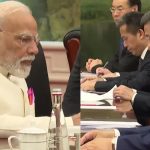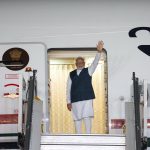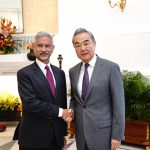 Blending pomp and ceremony with substantive outcomes, US President Barack Obama’s forthcoming visit to New Delhi promises to “reinvigorate” the multifarious India-US strategic partnership and reinforce the centrality of Washington as “a key partner” of New Delhi in the ongoing transformation of India and its aspiration to play a bigger role on the global stage.
Blending pomp and ceremony with substantive outcomes, US President Barack Obama’s forthcoming visit to New Delhi promises to “reinvigorate” the multifarious India-US strategic partnership and reinforce the centrality of Washington as “a key partner” of New Delhi in the ongoing transformation of India and its aspiration to play a bigger role on the global stage.
Obama’s India Itinerary
The broad outlines of the itinerary of President Obama, which was kept under wraps, is now official. Accompanied by his wife Michelle and a heavy-weight delegation, Obama, the first Afro-American president of the US, will touch down in Delhi on the morning of January 25 to begin a three-day trip that is poised to pitchfork what he has eloquently described as “the defining partnership of the 21st century” into a higher orbit. Immediately after arriving, the American president will be accorded a grand welcome at the majestic red sandstone palace, Rashtrapati Bhavan, with President Pranab Mukherjee and Prime Minister Narendra Modi present at the ceremonial function.
 The president then heads to Raj Ghat, the memorial dedicated to Mahatma Gandhi, India’s national icon whose photo Mr Obama keeps in his Oval office, before sitting down for wide-ranging talks with Prime Minister Modi and his delegation. Mr Modi will host a lunch for his American guest and his delegation, followed by a lavish banquet to be hosted by President Mukherjee in the evening.
The president then heads to Raj Ghat, the memorial dedicated to Mahatma Gandhi, India’s national icon whose photo Mr Obama keeps in his Oval office, before sitting down for wide-ranging talks with Prime Minister Modi and his delegation. Mr Modi will host a lunch for his American guest and his delegation, followed by a lavish banquet to be hosted by President Mukherjee in the evening.
Day 2 will see President Obama gracing the Republic Day parade, the first American president to soak in a veritable spectacle blending India’s multi-cultural mosaic and the country’s military might. He is expected to mingle with the power pack of India at the At Home reception hosted by the president of India. It will be time for business in the evening, with both Mr Modi and Mr Obama addressing the crème de la crème of India’s corporate world at the India-US CEOs forum.
Day 3, the last day of Mr Obama’s trip, will be time for soaking in the timeless splendour of the immortal Taj Mahal and a public speech in Delhi that will unveil President Obama’s vision on the next steps in the evolving India-US partnership.
India upbeat: US a key partner
 Ahead of the trip, both India and the US have struck an upbeat note. “We see President Obama’s visit as strengthening our ties across the full breadth of our relations – ties between our governments, our peoples and our institutions,” said Syed Akbaruddin, spokesperson of India’s ministry of external affairs, in New Delhi January 22.
Ahead of the trip, both India and the US have struck an upbeat note. “We see President Obama’s visit as strengthening our ties across the full breadth of our relations – ties between our governments, our peoples and our institutions,” said Syed Akbaruddin, spokesperson of India’s ministry of external affairs, in New Delhi January 22.
“The visit of President Obama is the culmination of a qualitative reinvigoration of our ties following the meeting between President Obama and Prime Minister Modi in September 2014,” he said.
Placing the pivotal role of the US in the ongoing project of national renewal for India, the spokesperson described the US as India’s key partner for capital, knowledge, technology and skills and a potentially important source of clean energy technology and technology.
The US is “an important partner in areas like defence technology and counter-terrorism; an important factor in our space security and cyber security; a key interlocutor in adjustments to the global security and economic architecture including reforms of the UN Security Council; a partner in the quest for a rule based, open international trading and economic order; and in our efforts to seek peace and stability in our extended neighborhood and globally.”
US bets on India opportunity
 Washington is also betting big on Obama’s visit and has underlined multiple advantages for the US in building a closer and multi-faceted relationship with India. “This is an enormously important event for the Indian people, and for President Obama to be invited as the first U.S. President to attend as the chief guest sends a very important message to the world as well as to the American and Indian people about our commitment to embrace the potential of this relationship,” said Ben Rhodes, US deputy national security advisor for strategic communications, in an interaction with the media from Washington.
Washington is also betting big on Obama’s visit and has underlined multiple advantages for the US in building a closer and multi-faceted relationship with India. “This is an enormously important event for the Indian people, and for President Obama to be invited as the first U.S. President to attend as the chief guest sends a very important message to the world as well as to the American and Indian people about our commitment to embrace the potential of this relationship,” said Ben Rhodes, US deputy national security advisor for strategic communications, in an interaction with the media from Washington.
Mr Rhodes stressed that “our goal is to leave this relationship in a fundamentally different place than it was when President Obama took office and when Prime Minster Modi took office.” “And we believe that we have a unique moment of opportunity to have that type of breakthrough.”
“It goes without saying that this is a seminal moment in the bilateral relationship, and that the extension of this invitation by the Prime Minister really continues to set a different tone for our reinvigorated partnership,” said Phil Reiner, National Security Council Senior Director for South Asia.
The Way Ahead: A Preview
 Both Indian and US officials underscored the intertwining of a host of strategic and economic imperatives that are driving the world’s two largest democracies in a closer embrace. The focus will on the “translating the extraordinary potential of relationship into concrete benefits for both of our peoples,” said Mr Rhodes.
Both Indian and US officials underscored the intertwining of a host of strategic and economic imperatives that are driving the world’s two largest democracies in a closer embrace. The focus will on the “translating the extraordinary potential of relationship into concrete benefits for both of our peoples,” said Mr Rhodes.
On the bilateral track, one can expect progress in diverse areas, including the fast-tracking of the nuclear deal and the renewal of the defence framework agreement, with increased focus on co-development and co-production of high-tech weaponry. In the economic sphere, the two sides have already raised the bar by setting an ambitious target of upscaling bilateral trade to $500 billion by 2020 and will be looking to size up fresh investment opportunities in both countries. The key will lie in walking the talk and delivering promised outcomes within set deadlines.
On the geopolitical plane, the two countries will be looking to impart a new resonance to the strategic partnership by exploring areas of convergence and cooperation across a host of regional and global issues, including Afghanistan, the AfPak region, the rise of China and the evolving Indo-Pacific architecture.
Headline-hunters may be disappointed though; breakthroughs and big-ticket outcomes may not be immediately visible, but the broad paradigm of the India-US has shifted to a point when there is greater comfort and assurance in the relationship so that the two countries can shed the temptations of hype and quietly and incrementally fructify what they have promised to do, and sustain an enduring and mutually empowering partnership.
Author Profile

- Manish Chand is Founder and Editor-in-Chief of India Writes Network (www.indiawrites.org) and India and World, a pioneering magazine focused on international affairs. He is CEO, Centre for Global India Insights, an India-based think tank focused on global affairs.
Latest entries
 India and the WorldAugust 31, 2025Message from Modi-Xi meeting: It’s the right choice to engage and be friends
India and the WorldAugust 31, 2025Message from Modi-Xi meeting: It’s the right choice to engage and be friends DiplomacyAugust 29, 2025Ahead of China visit, Modi eyes Japan opportunity
DiplomacyAugust 29, 2025Ahead of China visit, Modi eyes Japan opportunity India and the WorldAugust 27, 2025SCO summit: ‘Tianjin Test’ for India’s terror concerns
India and the WorldAugust 27, 2025SCO summit: ‘Tianjin Test’ for India’s terror concerns India and the WorldAugust 19, 2025Ahead of PM Modi’s visit, China strikes positive note on rare earths, de-escalation
India and the WorldAugust 19, 2025Ahead of PM Modi’s visit, China strikes positive note on rare earths, de-escalation







